Ferrari California 2010 User Manual

Owner's manual
U.S. and Canada Version Model Year 2010


General notes
This vehicle, which complies with the NHTSA / EPA certification standards, uses advanced technology and is capable of achieving high performance levels.
It is equipped with sophisticated active and passive safety systems (described below); these features and systems do not authorize the driver to take risks other than those involved in normal driving, since the preventive and protective action of these devices is provided only in certain conditions. Unless otherwise instructed specifically by Ferrari (see the Safety chapter), the deactivation of any vehicle restraint systems is PROHIBITED.
While certain safety devices (e.g., the airbags) have been designed to help ensure that they provide optimal levels of protection, they may nonetheless be hazardous in the event of failure by the driver or passenger to observe the instructions given by Ferrari. All vehicle occupants must be attentive at all times and take particular care when transporting passengers who are more subject to injury, such as children, disabled and elderly persons.
For safe driving, the following conditions must ALWAYS be met:
-the driver must be in good physical condition
-road regulations must be strictly observed
-common rules of caution must always be observed in relation to the quality/performance of the vehicle, driving conditions and contingent situations.
-Driving takes place in a naturally dangerous context where a number of different risk factors interact. For this reason, it is important to drive bearing in mind that others, whether they are pedestrians, motorcyclists or motorists, can make mistakes. Keeping a safe distance helps you reacting in emergency situations.
Distractions and underestimating danger are the cause of most accidents.
-Caution and discipline are the basis of safe driving. Correct and careful use of a vehicle derives from respect for one's own safety and that of others, as well as from compliance with road regulations.
Ferrari recommends reasonable and careful use of the vehicle. The driver MUST NEVER allow passengers to increase the risks associated with driving (e.g., by not using safety systems such as the seat belts) by failing to observe the mandatory safety rules that apply to both driver and passengers. All occupants must wear their seat belts at all times!
The vehicle MUST NOT be modified or tampered with for any reason whatsoever since, by so doing, the manufacturer's homologation and safety parameters will be modified.
The owner of the vehicle is obliged to perform careful maintenance on the vehicle in compliance with the recommended maintenance schedule.
• 4

The driver must pay particular attention to the signals of the vehicle, especially the warning lights on the dashboard and buzzers. Even when the warning lights do not indicate a situation of immediate danger, the driver must be cautious in relation to possible consequences/degeneration of the failure and other information given.
Even during routine operations, such as refueling, precautions should always been taken and it is important to check that flammable liquid has not been spilled; these precautions must be observed even if the operation is performed by others. Similarly, before starting off make sure that the doors are closed by checking the warning lights and also manually. The driver must be fully knowledgeable with the vehicle
and its controls in order to handle and drive it correctly. Knowledge of the vehicle can be achieved/improved by attending the driving courses held by Ferrari, which are recommended.
The use of motor sports terms (such as F1, SPORT and RACE) is merely indicative of the competition-derived technology and suspension systems in the vehicle and does not endorse any inappropriate behavior on the road which does not comply with traffic regulations.
The above is a general outline of some of the issues described in detail in this manual.
General notes
Remember that state, national and international legislation requires that the driver of the vehicle must be capable of performing corrective and/or emergency maneuvers at all times. The driver must also use any on-board information, communication and entertainment systems responsibly, especially when the vehicle is in motion. Examples of information, communication and entertainment systems are the following: satellite navigation systems, traffic information systems, media players (e.g., iPod), telephones with Bluetooth connectivity, etc. (whether audio-based or with display).
The driver must bear in mind that on-board systems may cause distraction while driving, since they may require the driver to turn his attention away from the road for several seconds. Aftermarket video entertainment systems for the passenger (e.g. TV) must be installed only where they will not distract the driver while the vehicle is in motion.
These systems may only be operated by the driver:
-in complete safety (stopping the vehicle before use if necessary);
-putting road safety first; for example, in poor or limited visibility conditions, looking at a display with active programs can be distracting if you take your eye off the road, even for a split second.
• 5

While the vehicle is in motion, the attention required to use on-board systems must never exceed the high level of attention required to drive safely in accordance with the traffic regulations:
-if the previous vehicle owner had installed systems on the vehicle that are NOT APPROVED by Ferrari (e.g., car tuning), ensure that they are fully compatible with the original vehicle equipment;
-in some countries, the use of entertainment/information systems on vehicles is prohibited while driving.
The driver is responsible for the use of these entertainment/ information systems with video screens if they are prohibited in the country where the vehicle is driven.
Strict priority criteria must be observed when driving a vehicle: you must not therefore take your attention and eyes off the road. Operations not involved with driving (e.g., changing dashboard functions) must be performed in maximum safety when the vehicle is stationary.
THE NHTSA’S TOLL-FREE AUTO SAFETY HOTLINE
If you believe that your vehicle has a defect which could cause a crash or could cause injury or death, you should immediately inform the National Highway Traffic Safety Administration (NHTSA) in addition to notifying Ferrari S.p.A.
If NHTSA receives similar complaints, it may open an investigation, and if it finds that a safety defect exists in a group of vehicles, it may order a recall and remedy campaign. However, NHTSA cannot become involved in individual problems between you, your dealer, or Ferrari S.p.A.
To contact NHTSA, you may call the Vehicle Safety Hotline toll-free at 1-888-327-4236 (TTY: 1-800-424-9153) (Media inquires: 202- 366-9550);
go to http://www.safercar.gov; or write to: Administrator, NHTSA, 1200 New Jersey Avenue, SE West Building, Washington, DC 20590. You can also obtain other information about motor vehicle safety from http://www.safercar.gov.
THE TRANSPORT CANADA TOLL-FREE AUTO SAFETY HOTLINE
If the affected vehicle is not repaired free of charge to you and within a reasonable time, you may submit a written complaint to Head
of Recalls, Road Safety and Motor Vehicle Regulation, Transport Canada, 2780 Sheffield Road, Ottawa, Ontario KIB 3V9. You may also telephone Transport Canada at (613) 993-9851.
• 6

FUELS CONTAINING ALCOHOL
For its fuel injection systems, Ferrari uses components and materials of very high quality. However, no specific tests have been carried out to assure the reliability of the system when using fuel containing alcohol. Consequently, we recommend that you do not use fuel containing alcohol on Ferrari vehicles.
• 7

Introduction
The aim of this Owner’s Manual is to inform you in the proper use of your vehicle, to help you get the best value from your vehicle and to provide information on routine maintenance: we advise you to read it carefully before driving. The Owner's Manual should be considered an integral part of the vehicle and must therefore always be kept on board.
Using the vehicle in a way that does NOT comply with the Owner's Manual not only exonerates Ferrari of any responsibility but also puts the person at great risk.
Updating
The high quality level of the vehicle is subject to constant technological improvements. Therefore, there may be differences between this manual and your vehicle.
Your Authorized Ferrari Dealer will be pleased to provide you with all the information on any important updates.
All specifications and illustrations contained in this manual refer to those resulting as of the printing date. Specifications may be changed without prior notice.
Spare parts
When replacing parts or topping up with lubricants and fluids, we recommend that you use genuine spare parts and the lubricants and fluids recommended by Ferrari.
The Ferrari warranty is voided if Genuine Ferrari Spare Parts are NOT used for repairs.
Warranty Book
Each new vehicle comes equipped with a “Warranty Book”. This contains the vehicle warranty terms and conditions.
The Warranty Book also contains the routine maintenance indicated in the “Maintenance Schedule”
Service
The information in this manual is necessary for the proper use and care of the vehicle. In addition, Customers will get maximum satisfaction and results from the vehicle if they carefully follow the instructions contained in it.
We recommend that you have all the checks and services performed at an Authorized Ferrari Dealer since they have highly skilled staff and the necessary equipment.
Please refer to the “Sales and Service Organization” manual for information on the location of the Authorized Ferrari Dealers.
The Ferrari Technical Service Department is at your complete disposal for any information and advice.
• 8
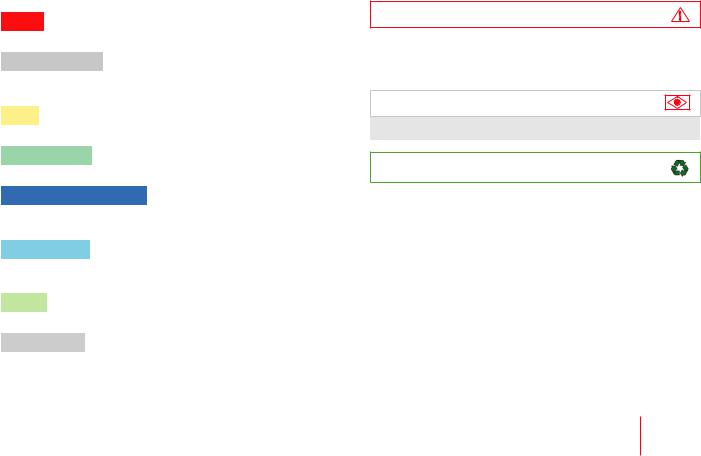
Consulting the manual
To facilitate reading the manual, the topics have been divided into sections and chapters.
To further facilitate consultation, each section is identified by a specific color:
General
Provides general information about your vehicle.
Quick reference guide
Contains all the information you need when using the vehicle for the first time.
Safety
Describes the main safety systems in the vehicle.
About your Vehicle
Provides all necessary information for use of the vehicle.
Advice for Emergency Situations
Provides useful advice for solving certain problems that may occur.
Care of the vehicle
Provides advice for cleaning, care and routine maintenance of your vehicle.
Glossary
Explains the main technical concepts.
Table of Contents
Allows you to quickly identify and locate the information required.
Within the various sections, special attention must be paid to the parts marked as follows:
Warning
Extreme caution required: failure to comply with the instructions could constitute a serious risk to personal safety and vehicle protection!
Important note
Important note: a note containing instructions or information.
Environment
Warning for environmental protection: useful advice for protection of the environment.
• 9
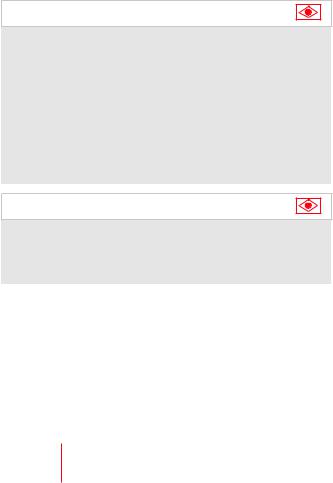
DCT gearbox
Important note
The vehicle is equipped with an electro-hydraulically controlled gearbox system by means of paddles located behind the steering wheel.
The default setting for the DCT gearbox is always “Auto” mode.
Every time the vehicle is started, the DCT gearbox is in “Auto easy exit” mode unless the vehicle was in “Auto” mode when it was turned off.
To exit the “Auto easy exit” mode operate the UP or DOWN paddle (while the vehicle is moving) or press the AUTO button on the center console.
Important note
Although the system can be used in “Auto” mode, it should not be considered an automatic gearbox and therefore, to use it correctly, always follow the instructions given in this manual on page 168.
Abbreviations/Acronyms |
|
Some descriptions and terms with particular meanings are |
|
found in this manual in an abbreviated form: |
|
A.C. |
Air-conditioning |
ABS |
Anti-lock Braking System |
ASR |
Anti-skid Regulation during acceleration |
EBD |
Electronic Brake-force Distribution |
CST |
Stability and Traction control |
ECU |
Electronic Control Unit |
F1-Trac Traction control derived from the technologies used in |
|
|
the racing sector |
PS |
Performance Start |
DCT |
Dual Clutch Transmission |
For an overview of the abbreviations contained in this manual, |
|
please see the Glossary. |
|
• 10
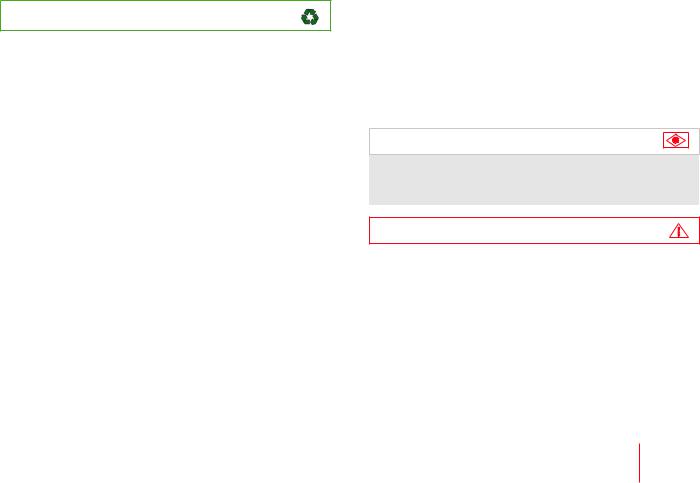
Environmental protection
Environment
The following section contains useful advice for environmental protection.
Ferrari has designed and constructed a vehicle using technologies, materials and devices with the aim of reducing the harmful impact on the environment to a minimum.
Using your vehicle with respect for the environment will contribute towards environmental protection.
Fuel consumption as well as engine, gearbox, brake and tire wear mainly depend on two factors:
-use of the vehicle
-driving style.
Both factors are influenced by the driver.
Use of the vehicle
-Avoid using the vehicle for short trips.
-Check that the tire pressure is correct.
-Check fuel consumption.
-Proper periodic maintenance will contribute to preserving your vehicle in full working order and will help protect the environment.
We therefore advise you to respect the service due dates indicated in the “MAINTENANCE SCHEDULE”.
Driving style
-Do not accelerate during the starting procedure.
-Do not warm up the engine when the vehicle is stationary.
-Drive prudently and keep a safety distance suited to the driving speed.
-Avoid sharp and frequent accelerations.
-Turn off the engine if the vehicle is kept stationary for long periods of time.
-Shift gears using only 2/3 of the speed permitted for each gear.
Important note
The vehicle is equipped with exhaust gas control and monitoring systems which must always function properly and be checked regularly.
Warning
Engine exhaust, some of its constituents, and certain vehicle components contain or emit chemicals known to the State of California (CA) to cause cancer and birth defects and reproductive harm.
In addition, certain fluids contained in vehicles and certain products of component wear contain or emit chemicals known to the State of California (CA) to cause cancer and birth defects or other reproductive harm.
Battery posts, terminals and related accessories contain lead and lead compounds. Wash your hands after handling.
Used engine oil contains chemicals that have caused cancer in laboratory animals. Always protect your skin by washing thoroughly with soap and water.
• 11

Vehicle event data
The driving and safety systems employed in your vehicle use computers that monitor, and share with each other, information about your vehicle operation. One or more of these computers may store certain monitored information, either during normal vehicle operation or in a crash or nearcrash event. Stored information may be read and used by:
•Ferrari North America, Inc.
•Ferrari S.p.A.
•Service and repair facilities
•Law enforcement or government agencies
•Others who may assert a legal right to know, or who obtain your consent to know such information.
• 12
1.General
2.Quick reference guide
3.Safety
4.About your vehicle
5.Advice for Emergency Situations
6.Care of the vehicle
7.Glossary
8.Table of Contents

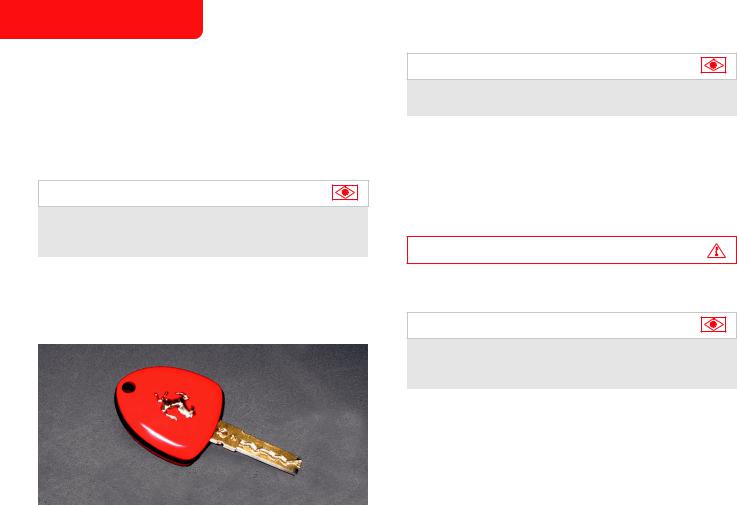
Vehicle keys
The vehicle is delivered with two identical keys that can be used for:
-central door locking / unlocking
-starting the vehicle
-activating/deactivating the alarm system
-opening the luggage compartment.
Important note
If the keys are lost or stolen, you can request a duplicate from your Authorized Ferrari Dealer (see section “Duplicating the keys” on page 18).
Important note
Make sure you record the code numbers in the space provided in the “Warranty Book”.
Key codes
A CODE CARD is supplied with the keys. This card shows the following:
-the electronic code
-the mechanical code for the keys, to be given to your Authorized Ferrari Dealer if you request duplicates of the keys.
Warning
The code numbers on the CODE CARD must always be kept in a safe and protected place, not accessible to others.
Important note
In the event of a change of ownership, it is essential that the new vehicle owner is provided with all the keys and with the
CODE CARD.
1• 16 |
|
· General · |
|
||
|
|
|
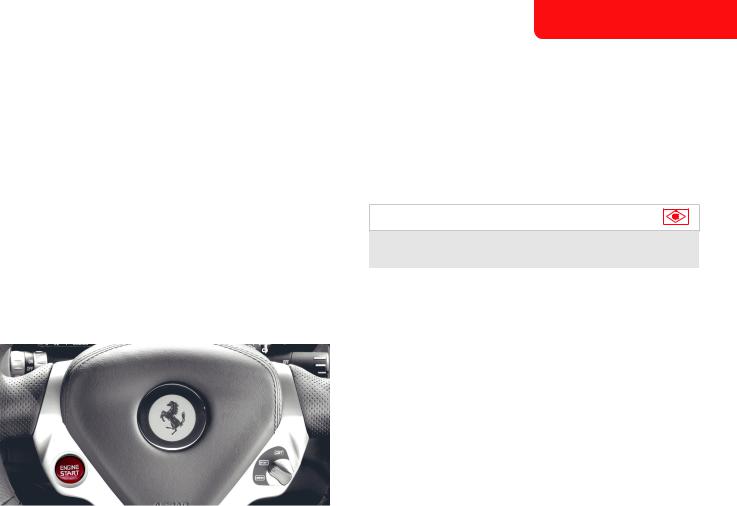
Alarm system
The Ferrari CODE system
The vehicle comes equipped with an electronic immobilizer system (Ferrari CODE) which is automatically activated when the ignition key is removed.
The keys are equipped with an electronic device which transmits a coded signal to the Ferrari CODE ECU. Once this ECU has recognized the signal, the engine can be started.
Operation
Each time the ignition key is removed from the 0 position, the protection system activates the engine immobilizer.
-When starting the engine, press the ENGINE START button on the steering wheel:
1)If the code is recognized, the CODE warning light A on the instrument panel turns off when the check procedure has been completed, whereas the OBD warning light B turns off when the engine is started once the ECU has completed its diagnostic cycle. In these conditions, the protection system has recognized the key code and deactivated the immobilizer.
2)If the CODE warning light A illuminates permanently, it means that the code has not been recognized. In this case, it is advisable to turn the key back to position 0 and then back to II. If the immobilizer device remains active, try with the other key.
Important note
If you still cannot restart the engine, contact your Authorized Ferrari Dealer.
B |
A |
· General · |
|
1• 17 |
|
||
|
|
|
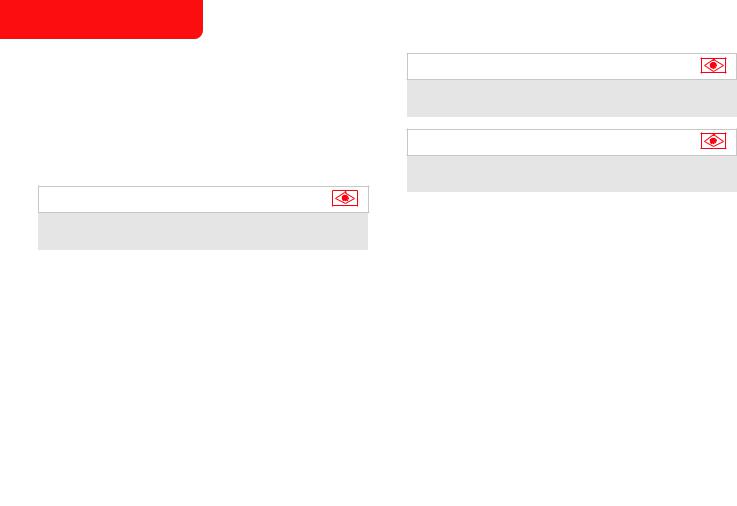
- While driving, with the ignition key in position II:
1)If the CODE warning light A illuminates, it means that the system is performing a self-diagnostic cycle. At the fi rst
opportunity, you can stop and test the system: stop the engine by turning the ignition key to position 0, then turn the key back to position II. The CODE warning light A will illuminate and should go off within one second. If the warning light stays on, repeat the procedure described previously leaving the key at 0 for more than 30 seconds.
Important note
If the problem persists, please contact your Authorized Ferrari Dealer.
2)If the CODE warning light A fl ashes, it means that the vehicle is not protected by the immobilizer.
B |
A |
Important note
Contact your Authorized Ferrari Dealer immediately to have all the keys stored in the system memory.
Important note
Each key provided has its own specifi c code, which must be stored in the memory of the system control unit.
Duplicating the keys
If you request additional keys, provided that the conditions to satisfy your request are met, remember that the codes must be stored (up to a maximum of 7 keys) on all the keys.
Contact your Authorized Ferrari Dealer directly and bring the following with you:
-all the keys in your possession
-the CODE CARD for the Ferrari CODE system
-a personal identity document
-the documents proving ownership of the vehicle.
The codes of the keys that are not available when the new memorization procedure is performed will be deleted from the memory, in order to prevent that any lost or stolen keys are used to start the vehicle.
1• 18 |
|
· General · |
|
||
|
|
|
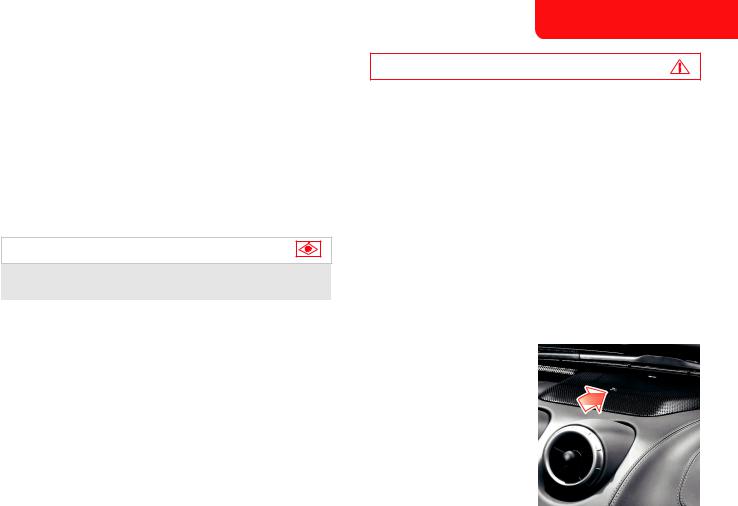
Replacing remote control batteries
If you press one of the three buttons of the key and this does not activate the corresponding function, check for correct operation of the alarm system functions using the other remote control before replacing the batteries.
Replace the remote control batteries as follows:
-open the key cover C using a small screwdriver at the position indicated by the arrow
-remove the battery E pushing in the direction indicated by the arrow to release it from the retainer cover D
-fit a new battery of the same type, observing the indicated polarity;
-close the key cover C.
Important note
Do not use sharp tools to remove the cover and be careful to avoid damaging the remote control.
Warning
There is risk of explosion if the battery is replaced with an incorrect type.
Dispose of used batteries according to the instructions.
Electronic alarm
The electronic alarm system performs the following functions:
-remote control for central door locking/unlocking
-perimeter surveillance, detecting if doors and lids are opened
-motion surveillance, detecting intrusion in the passenger compartment
-vehicle movement surveillance.
Activation
To activate the electronic alarm, press button F on the key:
-the direction indicators flash once
-the system “beeps”
· General · |
|
1• 19 |
|
||
|
|
|

-the red LED on the dashboard flashes
-the central door locking system is activated and the doors are locked. The system activates after approximately 25 seconds.
When the electronic alarm is activated, the user may request opening of the luggage compartment; in this case, the motion and anti-lift sensors are temporarily deactivated.
If the luggage compartment is then closed, the sensors will be reactivated.
If the direction indicators and the red LED on the dashboard flash 9 times when you activate the alarm system, this means that one of the doors or the front/rear lid is not properly closed and therefore is not protected by the perimeter surveillance. Check for correct closing of the doors, front/rear lid and close any open door or lid without deactivating the alarm system. The direction indicators flashing once indicate that now the door or the front/rear lid is closed properly and is protected by the perimeter surveillance.
Warning
If the direction indicators and the red LEDs on the dashboard flash 9 times when the alarm system is activated with doors, rear and front lids properly closed, it means that the self-diagnostic feature has detected a malfunction in the system. Contact your
Authorized Ferrari Dealer to have the system checked.
Deactivation
To deactivate the alarm system press button G on the key:
-the direction indicators flash twice
-the system beeps twice
-the red LED on the dashboard turns off
-the dome lights and the lights under the doors illuminate
-the central door locking system is deactivated and the doors are unlocked.
Pressing button G twice unlocks the doors and also turns on the low beams for 30 seconds.
The alarm system is off and it is therefore possible to get into the vehicle and start the engine.
If the remote control battery is dead, to enter the vehicle, insert the key into one of the two door locks, then turn it to release the lock. The alarm siren will start to sound.
Start the vehicle following the standard procedures. The alarm siren will deactivate.
1• 20 |
|
· General · |
|
||
|
|
|
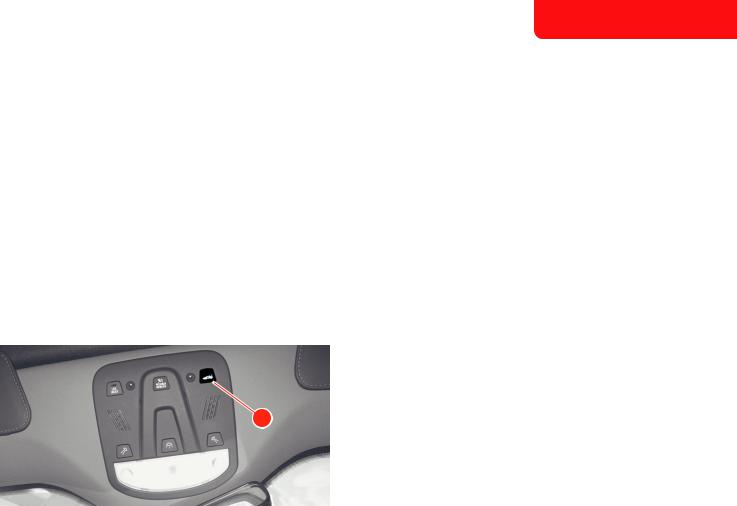
Deactivating the anti-lift alarm
Press button H to deactivate the anti-lift alarm system. When this function is deactivated, the LED on the button will flash for about 3 seconds and will then turn off.
Alarm memory
If the CODE warning light illuminates on the display when the vehicle is started, this means that an intrusion has been attempted.
The alarm system memory is reset by turning the ignition key.
In this case, the system will indicate the reason for the alarm activation according to the following priority:
-LED off twice: lifting sensor alarm
-LED off three times: door alarm
-LED off four times: luggage compartment lid alarm
-LED off five times: ignition key alarm.
The alarm system memory is reset by turning the ignition key.
· General · |
|
1• 21 |
|
||
|
|
|

Identification plates and labels
A Assembly number plate
B Emission control data label C V.I.N. plate
D Fuel label
E Paintwork label F Oil check label
G Engine/gearbox oil type label H TPMS label
IAnti-freeze label
J Airbag maintenance label K Airbag warning label
L Engine type and number M Tire pressure and type label N Gearbox type and number O Chassis number plate
P Retractable hard top warning labels Q Mercury content warning label
R Child seat warning label
K |
O |
D |
P |
|
R |
|
J |
|
G |
|
N |
|
C |
|
F |
I |
Q |
H |
M |
E |
A |
B |
L |
1• 22 |
|
· General · |
|
||
|
|
|
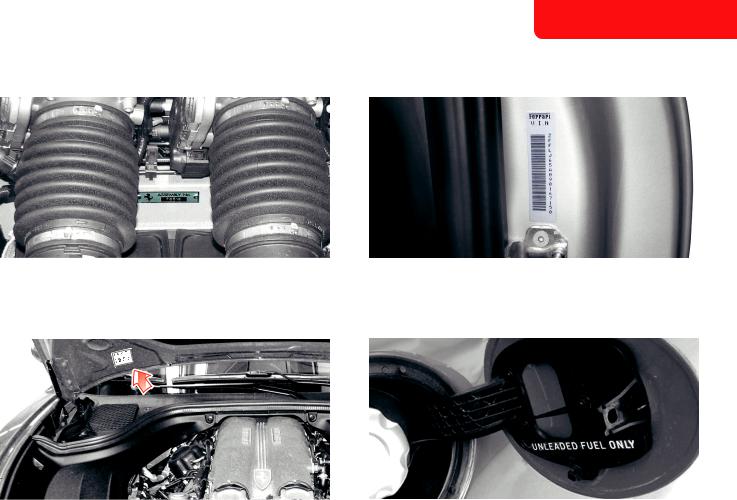
A Assembly number plate |
C V.I.N. plate |
B Emission control data label |
D Fuel label |
· General · |
|
1• 23 |
|
||
|
|
|

E Paintwork label |
G Engine/gearbox oil type label |
F Oil check label |
H TPMS label |
1• 24 |
|
· General · |
|
||
|
|
|
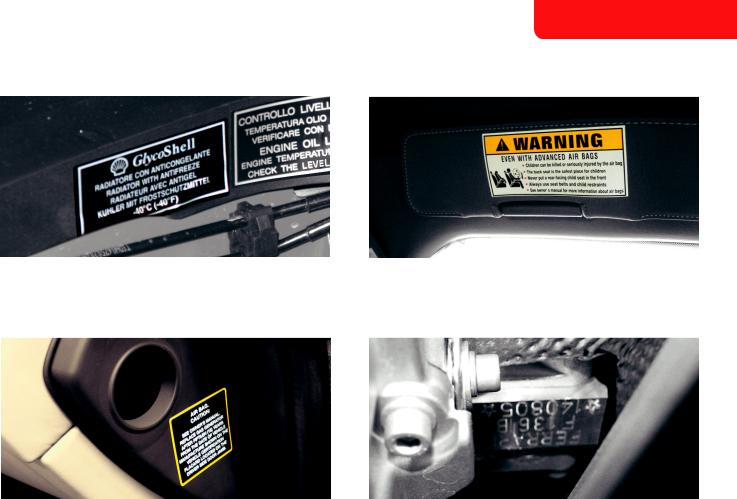
I Anti-freeze label |
K Airbag warning label |
J Airbag maintenance label |
L Engine type and number |
· General · |
|
1• 25 |
|
||
|
|
|
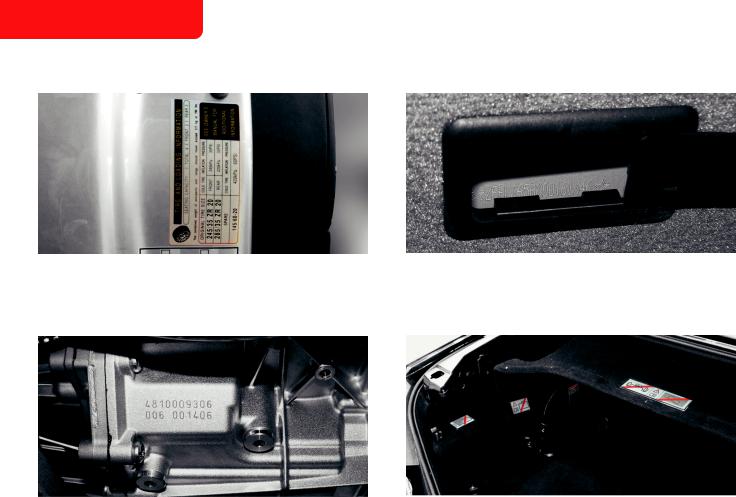
M Tire pressure and type label |
O Chassis number plate |
N Gearbox type and number |
P Retractable hard top warning labels |
1• 26 |
|
· General · |
|
||
|
|
|

Q Mercury content warning label
R Child seat warning label
· General · |
|
1• 27 |
|
||
|
|
|
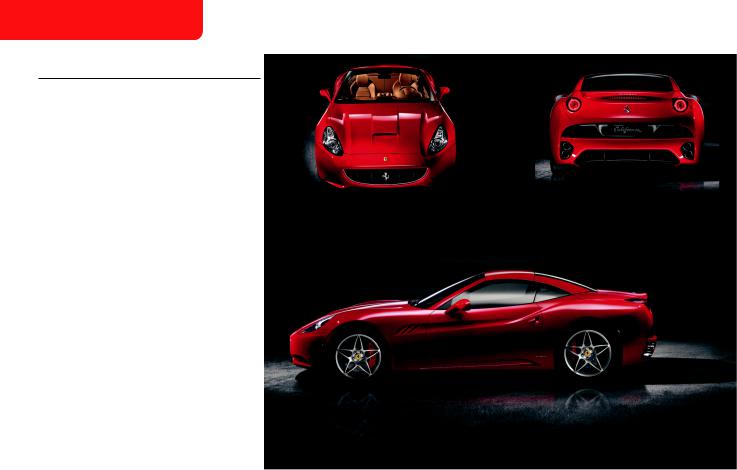
Dimensions and weights
Wheelbase |
105.12 in. (2670 mm) |
Max. length |
179.6 in. (4562 mm) |
|
|
Max. width |
75.15 in. (1909 mm) |
|
|
Max. height |
52.04 in. (1322 mm) |
Front track |
64.17 in. (1630 mm) |
Rear track |
63.18 in. (1605 mm) |
|
|
Front overhang |
37.4 in. (952 mm) |
|
|
Rear overhang |
37 in. (940 mm) |
Curb weight (DCT) |
3925 lb. (1780 kg)* |
*With the vehicle fitted with the most popular options available.
|
|
1• 28 |
|
· General · |
|
||
|
|
|

Main engine specifications
|
Engine Family |
AFEXV04.3GDI |
|
|
Type |
F 136 IB |
|
|
|
|
|
|
Number of cylinders |
8 |
|
|
|
|
|
|
Cylinder sequence |
V 90° |
|
|
Cylinder bore |
3.7 in. (94 mm) |
|
|
Piston stroke |
3.04 in. (77.4 mm) |
|
|
|
|
|
|
Total displacement |
4297 cm3 |
|
|
Compression ratio |
12.2:1 |
|
|
Maximum RPM |
8000 RPM |
|
|
(with limiting device) |
|
|
|
Max. power |
338 kW |
|
|
|
(453 HP) |
|
|
Corresponding RPM |
7750 RPM |
|
|
Max. torque |
357.7 ft. lb. |
|
|
|
(485 Nm) |
|
|
Corresponding RPM |
5000 RPM |
|
Transmission ratios
Gearbox |
Differential/bevel gear pair |
||
ratios |
|
ratio |
|
1 |
= |
2.822 |
|
2 |
= |
2.053 |
|
3 |
= |
1.379 |
4.444 |
|
|
|
|
4 |
= |
1.091 |
|
|
|
|
|
5 |
= |
0.966 |
|
6 |
= |
0.788 |
|
|
|
|
|
7 |
= |
0.651 |
|
R= 2.368
Performance
|
|
0 - 100 km/h |
0 - 400 m |
Max. speed |
|
|
|
(62 mph) |
(1,312 ft.) |
|
|
|
|
|
|
|
|
|
DCT |
3.9 s |
12.2 s |
> 192 mph |
|
|
|
|
|
(> 310 km/h) |
|
|
|
|
|
|
|
Electric system
Supply voltage |
Alternator |
|
|
12 V |
Nippondenso 150 A SC2 |
|
|
Battery |
Starter motor |
|
|
Fiamm 12V - 100 A/h - 850 A |
Nippondenso |
· General · |
|
1• 29 |
|
||
|
|
|

Fuel Consumption (miles per US Gallon)
DCT Gearbox Version
City |
15.5 |
|
|
Highway |
26.1 |
|
|
Average fuel consumption |
19 |
These estimates are based on tests performed on vehicles equipped with the most popular optional equipment.
The fuel economy values are calculated pursuant to the new EPA fuel economy labeling procedure for 2008 and later model years. You can also obtain other information from http://www. fueleconomy.gov.
Reminder: Your actual fuel consumption may vary depending on your driving style and habits, vehicle maintenance, optional equipment installed, road and weather conditions.
For best fuel economy, shift gears at the following speeds:
1st |
- |
2nd |
12,5 mph (20,12 km/h) |
2nd |
- |
3rd |
17,5 mph (28,16 km/h) |
3rd |
- |
4th |
22,5 mph (36,21 km/h) |
4th |
- |
5th |
27,5 mph (44,26 km/h) |
5th |
- |
6th |
32,5 mph (52,30 km/h) |
6th |
- |
7th |
37,5 mph (60,35 km/h) |
Shift Indicator Light (SIL) operating mode
The graphic symbol A appears just before
reaching the speed recommended for operating the UP lever. After shifting gears or after exceeding the
indicated speed, the indicator turns off even if no gearshift is performed.
A |
1• 30 |
|
· General · |
|
||
|
|
|
